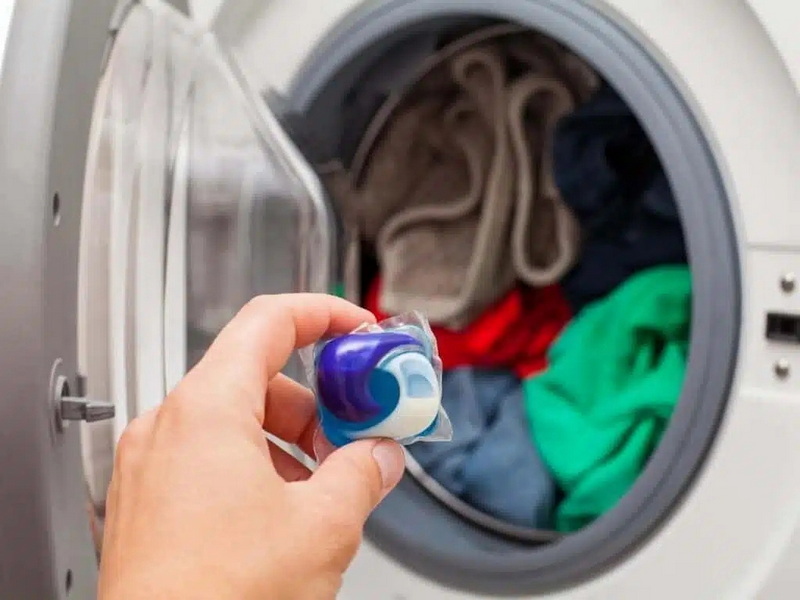Dongguan UFine Daily Chemical Co.,Ltd.
- All
- Product Name
- Product Keyword
- Product Model
- Product Summary
- Product Description
- Multi Field Search
Views: 222 Author: Tomorrow Publish Time: 10-23-2025 Origin: Site











Content Menu
● What Are Laundry Detergent Pods?
● Why Use Laundry Detergent Pods?
● How Many Laundry Detergent Pods Per Load?
>> Manufacturer's Recommendations
>> Factors Influencing the Number of Pods
>> Risks of Using Too Many Pods
>> Risks of Using Too Few Pods
● Best Practices for Using Laundry Detergent Pods
● Environmental and Safety Considerations
● Comparison: Pods vs. Liquid and Powder Detergents
● Additional Tips for Maximizing Pod Efficiency
● How to Identify When More or Less Pods Are Needed
● FAQ
>> 1. How many pods should I use for a small load?
>> 2. Can I use two pods for every load?
>> 3. Are laundry detergent pods safe for high-efficiency washers?
>> 4. What happens if I use too many pods?
>> 5. Can I cut pods in half if I have a small load?
Laundry detergent pods have become increasingly popular over the past decade due to their convenience, efficiency, and ease of use. These pre-measured capsules simplify the laundry process, preventing overdosing or underdosing detergent. However, one question many users have is: How many laundry detergent pods should be used per load? This article aims to provide a comprehensive answer to this question, analyzing factors that influence the number of pods required, benefits and drawbacks of using pods, practical tips for optimal usage, and safety considerations.

Laundry detergent pods are small, single-use packets containing concentrated liquid detergent encased in a dissolvable film. They combine detergent, stain removers, and sometimes fabric softeners into one convenient unit. Once placed inside the washing machine, the outer film dissolves, releasing the detergent to clean clothes effectively. Their compact form and ease of use make them very appealing compared to traditional liquid or powder detergents.
Pods are favored because they:
- Eliminate the need to measure detergent manually.
- Reduce the risk of spills and mess.
- Provide a precise amount of detergent for an average laundry load.
- Are compact and easy to store.
- Offer multi-functional cleaning power in one package, often including stain treatment or brighteners.
Despite these benefits, understanding the correct number to use per load is crucial to maintain washing effectiveness and avoid problems such as detergent residue, poor rinsing, or inadequate cleaning.
Most laundry detergent pods are designed with the amount of detergent optimized for a typical washer load. Standard advice is usually:
- Use 1 pod for a regular load (approximately 6-8 pounds or 2.7-3.6 kg of laundry).
- Use 2 pods for large or heavily soiled loads.
1. Load Size
Small or medium loads generally require only one pod. Oversized or bulky items like blankets or heavily soiled clothes may need an extra pod for thorough cleaning. For example, a large comforter or a load full of heavily stained sportswear may benefit from two pods.
2. Washing Machine Type
High-Efficiency (HE) machines use less water and require careful dosing. One pod is typically sufficient for an HE washer load. Using more than the recommended amount can cause oversudsing, which affects the machine's performance and can lead to residue buildup inside the washer.
3. Water Hardness
Hard water contains minerals like calcium and magnesium, which reduce detergent effectiveness. In areas with hard water, an additional pod or specialized detergent may be necessary to achieve cleanliness. Using water softeners or detergents formulated for hard water can also improve results.
4. Soil Level
Heavily stained or dirt-laden clothes might demand more detergent power, suggesting 2 pods. If your clothes have stubborn stains or you engage in outdoor work or sports, increasing detergent dosage helps break down tough grime.
5. Washing Cycle
Longer or heavier cycles, such as "heavy-duty" or "whites," often benefit from more detergent pods to ensure thorough cleaning. Short or delicate cycles usually require less detergent.
- Residue or white spots on clothes.
- Overly sudsy water can interfere with rinsing.
- Possible damage to delicate fabrics.
- Increased detergent waste and expense.
- Potential harm to washing machines through excessive sudsing.
- Clothes not cleaned properly.
- Persistent stains or odors.
- Potential buildup inside the machine due to insufficient cleaning agents.

- Always follow the dosage instructions printed on the pod package.
- Place pods directly into the wash drum before adding clothes to ensure proper dissolving.
- Avoid placing pods in the detergent drawer unless manufacturer guidelines allow, as this can prevent pods from dissolving fully.
- For high-efficiency machines, limit to one pod for regular loads.
- Increase to two pods only for heavily soiled or large loads.
- Use water temperature settings recommended on clothing labels and detergent packaging.
- Do not overload your washing machine, as overcrowding can inhibit proper detergent distribution and cleaning.
Laundry pods are convenient but pose some concerns:
- The plastic film dissolves safely in water but misuse or ingestion can be hazardous.
- Keep pods out of reach of children and pets due to toxicity risks. Children may mistake colorful pods for candy, so secure storage is essential.
- Use pods designed for your machine type and water conditions to reduce waste.
- Proper storage protects pods from moisture damage, which can cause them to clump or fail to dissolve properly.
- Consider environmentally friendly brands that offer biodegradable films and detergents with reduced environmental impact.
| Aspect | Pods | Liquid Detergent | Powder Detergent |
|---|---|---|---|
| Dosage Convenience | Pre-measured, easy to use | Requires manual measuring | Requires manual measuring |
| Cleaning Power | Concentrated, effective | Effective, adjustable dosage | Effective, may require dissolving |
| Storage | Compact, mess-free | Bulkier, potential spills | Bulkier, can clump or harden |
| Environmental Impact | Dissolvable film, less waste | Plastic bottles, more waste | Packaging waste, but recyclable |
| Risk of Overuse | Lower if following instructions | Higher if not careful | Higher if not careful |
- Do not combine pods with other detergents or additives unless the product specifies that it is safe to do so.
- Avoid pre-treating stains with pods; use specialized stain removers before washing.
- If you live in an area with very cold water, pods may dissolve slower; consider washing with warmer water or choosing a detergent suited for cold water.
- If clothes smell or look dirty after a wash, try increasing the number of pods.
- If your clothes feel sticky, stiff, or have visible detergent residue, reduce the number of pods.
- For sensitive skin, using fewer pods or switching to hypoallergenic pods may help prevent irritation.
The number of laundry detergent pods to use depends mainly on load size, machine type, soil level, and water conditions. For typical laundry, one pod per load is generally sufficient. Large or heavily soiled loads may require two pods. Using the correct number ensures clean clothes without detergent residue or waste. Following manufacturer guidelines and best practices will optimize washing results while preserving fabric quality and machine integrity. Additionally, awareness of safety and environmental considerations ensures responsible and effective use of detergent pods.

Use one pod for small or regular loads to avoid detergent residue and ensure proper cleaning.
No, using two pods for all loads can cause detergent buildup and waste; reserve two pods for large or heavily soiled loads.
Yes, but generally one pod per load is enough for HE machines to prevent oversudsing and maintain efficiency.
Using too many pods can leave soap residue on clothes, cause oversudsing, and potentially damage fabrics or your washing machine.
No, pods are designed to dissolve completely and cutting them may prevent proper dissolution and cleaning performance.